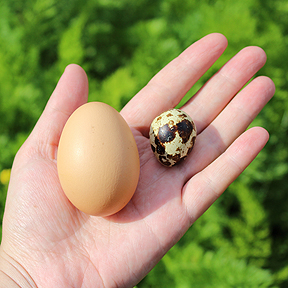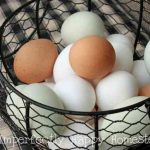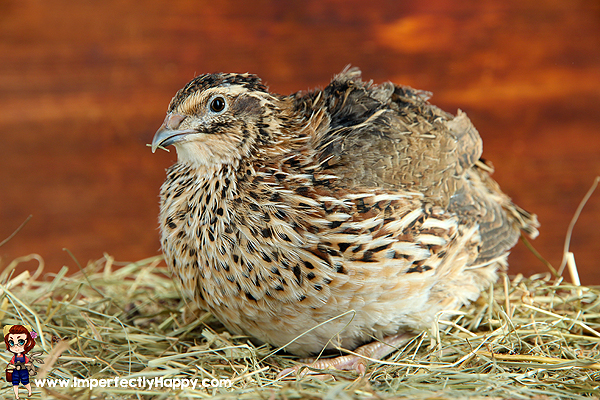
So you’re thinking about raising quail on your homestead. Awesome – they are a great addition to any homestead. They are especially great for those who don’t have a lot of space for other types of poultry. I’m going give you the nitty gritty basics on raising quail.
Why Start Raising Quail?
So maybe you’ve heard about quail but you aren’t convinced. Let me share my top 10 reasons to start raising quail on your homestead:
- They take up very little space – nothing compared to chickens, turkeys or ducks.

- Hens start laying eggs at about 6 – 8 weeks (compare that to your other egg layers!).
- Hens typically lay daily. The eggs are smaller, but I find them tastier. I do recommend getting a Quail Egg Shell Cutter
 because the shells are hard.
because the shells are hard. - They are also ready for processing at 6 – 8 weeks of age.
- They are quick to process and you don’t have to pluck.
- Most cities allow them as they are not considered livestock (check your ordinances).
- Quail eggs are known to have medicinal properties.
- Not a fortune to get started.
- Lower feed costs than chickens.
- Not broody (but fairly easy to incubate in 17-18 days).
How about that for starters? Now let’s go over what you’re going to need to get started.
Housing Quail
The general rule of thumb is 1 square foot of space per bird. Most people raise quail in battery cages and this works well for 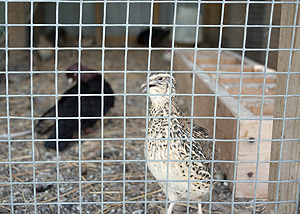 cleanliness and egg collection. I’m not a huge fan of cages but my quail did very well in them and it allowed me to keep them on my porch (with shade & misters in the summer). If you are going to keep your quail in cages I do suggest you give them some containers for dust bathing and consider adding in some natural elements, like branches for climbing.
cleanliness and egg collection. I’m not a huge fan of cages but my quail did very well in them and it allowed me to keep them on my porch (with shade & misters in the summer). If you are going to keep your quail in cages I do suggest you give them some containers for dust bathing and consider adding in some natural elements, like branches for climbing.
However quail can be raised in pens on the ground as well. It can be done as successfully as chickens with a coop and a yard. This type of “cage-free” housing allows the birds to live more naturally, take dust baths and graze on greens. Don’t believe all the hype about them having no instinct to do that anymore. I’ll go over natural housing in a future article.
I have also seen quail raised in convert rabbit hutches, though these typically don’t allow much space for many birds. This might work particularly well if you’re in an apartment or condo. I have a friend that raised her quail indoors; but she was cleaning cages twice a day (no thank you).
Please be aware that with any housing you’ll need to consider head protection. Quail can be quite flighty and when they are scared they’ll fly straight up. If you have a solid/hard roof, there is a good chance they’ll hurt or even kill themselves.
Keep your bird ratio to 1 rooster for every 4 – 5 hens.
Feeding Quail
When it comes to feeding your quail, protein percentage is key. I recommend a crumble with no less than 25% and that’s pushing it. When your quail aren’t getting enough protein they’ll start pecking on each other. I’ve found that the best feed is a good organic (non-gmo), non-medicated turkey starter. Quail also enjoy meal worms, bugs and greens (if they can’t do any foraging). Make sure your feeders are big enough for them to eat but not to get into – they love to waste food when given the opportunity. You may want to consider offering your caged quail grit also.
Always have plenty of water available.
A Note on Quail Roosters
Perfect example of a quail rooster, not mine.
I see a lot of bloggers writing about how quiet quail roosters are. This is a bit of a stretch…they are not quiet. They do not
make a traditional crow like a chicken but they definitely make noise. There call can blend in more with wild birds though, so that’s a plus. Our roosters were known to do their call in the dead of night…my neighbors just loved that (not). We decided that it wasn’t worth driving our neighbors crazy.
On the other hand, hens are virtually silent – no egg song like my Rhode Island Reds and Ameraucanas.
Quail Breeds to Consider
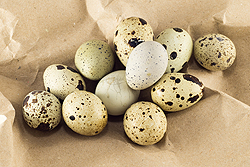 There are a lot domesticated quail breeds but I still think the Coturnix Quail is the gold standard. They are consistent, easier to sex and readily available in most areas. Make sure to check your city ordinances because not all breeds are legal in all places.
There are a lot domesticated quail breeds but I still think the Coturnix Quail is the gold standard. They are consistent, easier to sex and readily available in most areas. Make sure to check your city ordinances because not all breeds are legal in all places.
Other breeds to consider
- Jumbo Coturnix – bigger eggs, more meat (more feed).
- A&M – unlike most quail, these have a pure white meat.
- Tuxedo
- There are lots of other colors and varieties. I’ve found that the Coturnix is great for our climate.
Where to Purchase
I recommend finding a reputable breeder in your area. You can find quail groups on Facebook with lists of breeders by state. I have been able to find some quality birds on Craigslist but it is hit and miss. I prefer to buy adult birds because baby quail are fragile and require a little more work that a chicken chick. I typically pay about $3 – $5 depending on age.
Other Considerations while Raising Quail
- Quail are flyers. You may want to clip a wing for their protection and to keep your losses down. I never had one get away but I’ve heard stories.
- If you are raising quail for meat – you may need more than you think. A live Coturnix quail is less than a pound so one isn’t likely to be enough meat for an adult.
- Coturnix quail to not perch, so they don’t need a roost. But they do enjoy a box to duck inside of or shrubbery in their space.
- They are a nervous bird so providing them as quiet of a space as possible will make for happier and more productive birds.
Stay tuned for more posts on raising quail! In the meantime, feel free to ask questions in the comments.
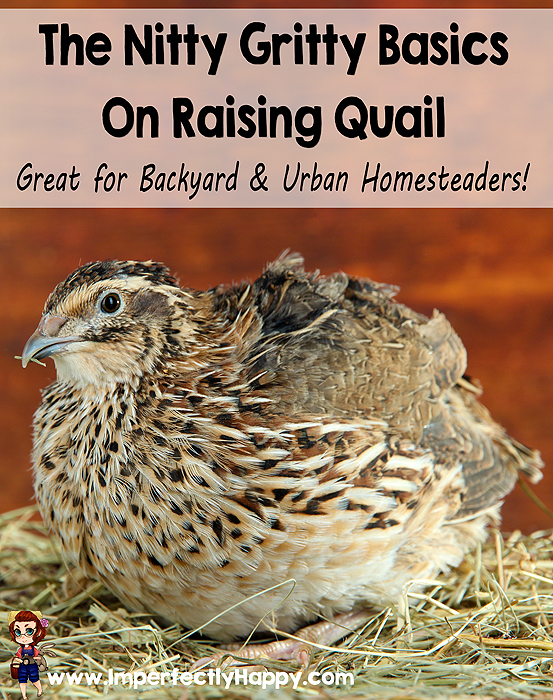
Never miss a post ~ Sign up for the Imperfectly Happy Newsletter
